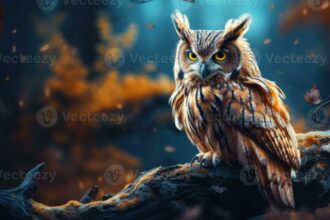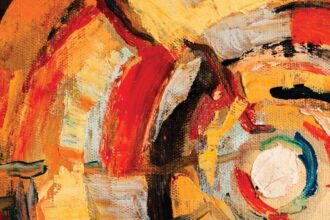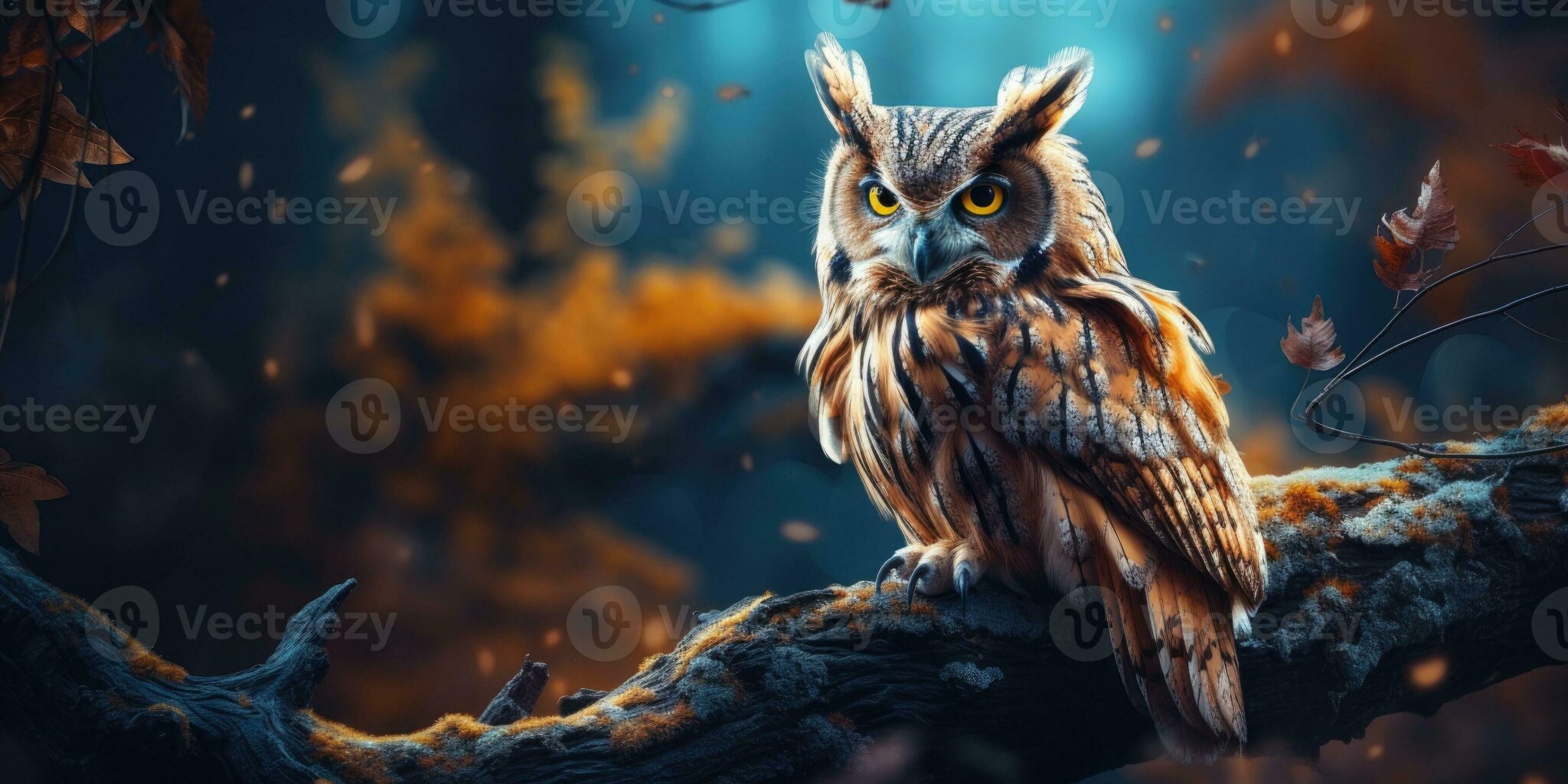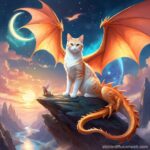In a forest where the moonlight whispers through the leaves and nighttime sounds create a lullaby, all the animals retreat to their cozy nests. The rabbits snuggle in their burrows, the squirrels curl up in treetops, and the deer rest in the meadow. But amidst this peaceful slumber, one creature remains wide awake—eyes open, watching the world under the silvery glow. This is the owl, with her wise, round eyes that shimmer like the night sky itself.
Every night, while others dream, she soars silently, her wings a gentle hum in the stillness. The question lingers: why does the owl never sleep while the rest of the forest rests? Is she guarding a secret only the stars know? Let’s embark on a journey to uncover the mystery of the owl’s wakeful nights.
The Origin of the Owls Eternal Vigilance
The story of the owl’s unwavering watchfulness is deeply rooted in ancient myths and the bird’s unique biological makeup. In many cultures, owls have been seen as symbols of wisdom, mystery, and sharp vision, traits that naturally tie into their reputation for being perpetually alert. One of the most enduring tales comes from Greek mythology, where Athena, the goddess of wisdom, was often depicted with an owl by her side. This sacred bird was said to possess the ability to pierce through darkness, both literally and metaphorically, embodying the idea of eternal vigilance. Over time, this myth transcended cultures, with similar stories appearing in Norse, Native American, and Asian traditions, cementing the owl’s reputation as a guardian of insight and awareness.
Owls’ physical adaptations further reinforce this notion of relentless watchfulness. Their large, round eyes are designed to capture even the slightest movement in low light, making them expert hunters under the cover of darkness. Additionally, their feathers are specially structured to allow silent flight, enabling them to stalk prey undetected. This combination of acute vision and stealth has led many to associate owls with being perpetually awake and observant. While owls, like all living creatures, need rest, their sleep patterns are brief and intermittent, with frequent moments of wakefulness to remain alert to their surroundings. This unique balance of rest and awareness has only added to their mystique as creatures of eternal vigilance.
- Their large, round eyes are designed to maximize vision in low light conditions, allowing them to detect even the slightest movements.
- Silent flight, made possible by specialized feather structures, enables them to hunt undetected, further enhancing their reputation as watchful hunters.
- Intermittent sleep patterns mean they are often seen as ”awake” even when resting, as they can quickly rouse to respond to their environment.
| Species | Unique Trait | Contribution to Vigilance |
|---|---|---|
| Barn Owl | Exceptional hearing | Detects prey underground, even in complete darkness. |
| Great Grey Owl | Large facial discs | Enhances auditory and visual focus. |
| Snowy Owl | White plumage | Blends into snowy environments, allowing silent observation. |

The Owls Big Eyes and the Gift of Night Vision
Owls are renowned for their oversized, round eyes that seem to hold the wisdom of the night. These eyes are not just a striking feature; they are a marvel of evolutionary engineering, designed to_masater the darkness. Unlike human eyes, which are spherical, an owl’s eyes are tubular, allowing for a larger cornea and lens to gather as much light as possible. This unique structure enables an owl to see in light conditions that would be pitch-black to humans, making their nighttime vigilance nothing short of extraordinary.
The secret to the owl’s incredible night vision lies in its retina, which is packed with light-sensitive rod cells that far outnumber those in human eyes. This allows the owl to detect even the faintest movements in low-light environments. Additionally, a reflective layer called the tapetum lucidum at the back of the owl’s eyes reflects light back onto the retina, maximizing light sensitivity. This is why an owl can spot a mouse scurrying across a moonlit field with ease, while the scene would appear nearly invisible to us. Their vision is so acute that they can even detect the heat signatures of prey through specialized sensors in their feathers.

Why the Owl Became the Guardian of the Moonlit Hours
In many ancient cultures, the owl is revered not just for its wisdom, but also for its enigmatic presence under the light of the moon. Legend has it that the owl was chosen by the spirits of the night to serve as the guardian of the moonlit hours—a role it accepted with grace andwit. The owl’s ability to thrive in darkness, coupled with its piercing gaze, made it the perfect sentinel for the mysterious and often misunderstood hours between dusk and dawn. Its nocturnal nature became both a gift and a responsibility, as it vowed to watch over the shadows and keep balance in the silent world of the night.
The owl’s guardianship is not merely symbolic; it is deeply rooted in its unique abilities. Keen vision, silent flight, and an acute sense of hearing make it a formidable protector of the night. Its role extends beyond mere observation—it is said to carry the whispers of the moon to those who seek truth in the darkness. Some believe the owl’s presence wards off harm, while others see it as a guide for those lost in the vast expanse of the night. Whether as a symbol or a living being, the owl embodies the essence of vigilant guardianship, earning its place as the eternal watcher of the moonlit hours.
| Aspect | Role of the Owl |
| Keen Vision | Monitors the night, discerning truth from illusion |
| Silent Flight | Glides unnoticed, a silent protector |
| Acute Hearing | Listens to the whispers of the night, guarding secrets |

The Owls Secret to Staying Awake All Night
Owls possess an extraordinary ability to remain awake and alert throughout the night, a trait that has captivated many for centuries. Their secret lies in their remarkable physical adaptations and behavioral strategies. The owl’s eyes are among its most striking features—immense and round, they are perfectly designed for low-light conditions. These eyes are not merely large; they are also tubular in shape, allowing them to gather as much light as possible. This unique structure, combined with a reflective layer called the tapetum lucidum located at the back of their eyes, helps them see in the dark by reflecting light back onto the retina. It’s like having a built-in flashlight, enhancing their night vision to uncanny levels. Additionally, owls can’t move their eyes like humans can, but they make up for it with their ability to rotate their heads up to 270 degrees, giving them a wide field of vision without missing a single movement.
But it’s not just about vision—owls have a suite of tricks to stay awake and active in the dark. Their acute hearing is another key factor; they can detect sounds as faint as a mouse scurrying through leaves. Some owl species even have asymmetrical ears, with one ear higher than the other, which helps them pinpoint the exact location of their prey. Owls are also masters of stealth, with specially designed feathers that allow them to fly silently, making it easier to hunt and stay undetected. Their nocturnal lifestyle is complemented by their ability to stay perfectly still for long periods, conserving energy while remaining vigilant. It’s a combination of biology, behavior, and evolution, making them the ultimate night hunters.
How the Owls Curiosity Keeps It Wide Awake
Owls are known for their extraordinary ability to remain vigilant, even during the quietest hours of the night. Their curiosity is not just a passing trait—it’s a deeply ingrained behavior that keeps them wide awake, even when the world around them seems to have come to a standstill. This innate curiosity drives them to explore their surroundings, listen to the faintest sounds, and observe the smallest movements. Whether it’s the rustling of leaves, the distant hooting of another owl, or the sudden flutter of wings, their keen senses are always on high alert, making it nearly impossible for them to tune out the world and drift off to sleep.
Their curiosity is further fueled by the fact that their survival depends on it. Owls are natural predators, and their ability to hunt effectively relies on their vigilance. Here are some reasons why their curiosity plays a crucial role in keeping them awake:
- Hunting Instincts: Owls are designed to hunt at night, and their curiosity helps them locate prey even in complete darkness. Every sound, no matter how faint, could signal the presence of a potential meal.
- Territorial Awareness: By staying awake, owls can monitor their territory for intruders, whether they are competitors or predators. This constant vigilance ensures they maintain control over their habitat.
- Social Behavior:** While owls are often solitary, they still communicate with others of their kind. Their curiosity helps them stay attuned to these interactions, which are vital for mating, warning calls, and establishing social bonds.
This constant state of alertness is not just about survival; it’s also a reflection of their unique biology. Owls have evolved to thrive in the night, and their curiosity is a key adaptation that allows them to make the most of their environment. Their ability to stay awake and aware is a testament to their remarkable resilience and intelligence.
The Owls Friendship with the Stars and the Night Sky
The owl’s affinity for the night sky is not merely a coincidence but a deep-rooted connection that has fascinated cultures and mythologies for centuries. In many ancient tales, the owl is often depicted as a celestial companion, whispering secrets to the stars or serving as a messenger between the earthly realm and the heavens. This bond is thought to originate from the owl’s nocturnal nature, as if the stars themselves had chosen the owl as their earthly confidant. The night sky, with its ever-changing canvas of constellations, is believed to provide the owl with guidance, inspiration, and even companionship during its lonely vigils. Some myths suggest that the owl’s wisdom is derived from the stars, as it listens to their silent stories and deciphers their cosmic language.
The owl’s friendship with the night sky is also practical. The moon and stars illuminate its hunting grounds, casting a silver glow over the landscape that helps the owl navigate and locate prey. In return, the owl honours this relationship by becoming a guardian of the night, silently patrolling the shadows to maintain balance in the ecosystem. This mutualistic bond is further highlighted by the owl’s ability to adapt to the phases of the moon, adjusting its hunting strategies based on the available light. The stars, in turn, are thought to celebrate the owl’s vigilance, twinkling in approval as the owl soars silently beneath them. Together, the owl and the night sky create a symphony of movement and light, a dance that has been perfected over millennia.
| Owl Species | Unique Night Sky Adaptation |
| Barn Owl | Uses the moon’s light to enhance its acute hearing for hunting. |
| Great Grey Owl | Relies on starlight to navigate during long migrations. |
| Tawny Owl | Recognized for its ability to hunt in complete darkness, guided by sound. |
The owl’s friendship with the stars and the night sky is a testament to the harmony that exists between nature and its creatures. In a world where light and darkness are ever-present, the owl stands as a symbol of the beauty and functionality of the night, proving that even in the absence of daylight, there is life, purpose, and profound connection.
Why the Owl Is Always Awake When Others Are Asleep
Owls are creatures of mystery, often seen perched silently in the dead of night while other animals slumber. Their nocturnal nature is rooted in biology and survival instincts. Unlike most birds and mammals, owls have evolved to thrive in the dark, equipped with excellent night vision, acute hearing, and silent flight abilities. These traits make them efficient hunters, capable of detecting prey that would otherwise remain hidden under the cover of darkness. Their large, round eyes are designed to gather as much light as possible, making them highly sensitive to even the slightest movements. This unique adaptation ensures that owls can roam freely while others are asleep, turning night into their domain.
Interestingly, owls don’t truly never sleep; they simply sleep less and at different times than diurnal creatures. During the day, they rest in secluded spots, often closing one eye to remain semi-alert. This strategic behavior allows them to conserve energy while staying prepared for potential threats. Owls are also known to take short naps, waking up periodically to check their surroundings. Their sleep patterns are a perfect balance between rest and vigilance, ensuring they are always ready to hunt or defend themselves. This unique lifestyle has led to the owl’s reputation as a wise and ever-watchful creature, perpetually awake while the world around them rests.
| Attribute | Why It Matters |
| Night Vision | Allows Owls to hunt in low-light conditions |
| Silent Flight | |
| Acute Hearing | Detects faint sounds of small animals |
| Semi-alert Resting | Maintains safety while conserving energy |
The owl’s ability to remain awake while others sleep has also made it a symbol of wisdom and mystery in many cultures. Its silence and observation skills suggest a deep understanding of its environment, as if it holds secrets that others cannot grasp. Whether perched in a hollow tree or swooping over a forest, the owl embodies the idea of being awake to the world’s hidden truths, even when darkness shrouds it. Its wakefulness is not just a survival strategy but a testament to its unique place in the natural world.
The Owls Wise Decision to Never Close Its Eyes
Owls have long fascinated humans with their mysterious gaze and silent nocturnal wanderings. These birds of the night have evolved an extraordinary ability to remain awake during the hours when most other creatures rest. Their eyes, often described as wise and all-knowing, are designed to remain open even in the darkest of nights. This unique trait is not just a matter of choice but a strategic adaptation to their environment, ensuring survival in a world where the cover of darkness is both a shield and a hunting ground. Their large, forward-facing eyes are not merely for show; they serve as powerful tools that capture even the faintest light, turning the blackest night into a stage for their silent pursuit of prey.
The owl’s decision to stay awake is rooted in its role as a apex predator. While it may seem counterintuitive to forgo sleep, their biology is finely tuned to thrive in the night. Their eyes are equipped with a reflective layer called the *tapetum lucidum*, which enhances low-light vision by reflecting light back onto the retina. This adaptation allows them to hunt with precision, even in conditions where other predators would falter. The owl’s nocturnal lifestyle is not a limitation but a strategic advantage, ensuring that it can feed and protect itself without competition. Below is a brief overview of the owl’s unique eye structure and its importance to their survival:
| Feature | Explanation |
|---|---|
| Large Pupils | Maximize light intake in low-light conditions. |
| Forward-facing Eyes | Enhance depth perception and focus on prey. |
| Tubular Shaped Eyeballs | Allow for greater light-gathering ability compared to spherical eyes. |
| Tапеtum Lucidum | A reflective layer that enhances night vision by reflecting light back onto the retina. |
The owl’s “wise decision” to never close its eyes is, in essence, an evolutionary masterpiece. It is a testament to nature’s ability to create creatures perfectly suited to their environments. The owl’s sleep patterns, though different from ours, are no less efficient; they take short naps during the day, resting while remaining alert to potential threats. Their awake nature is not just a quirk but a vital survival strategy, ensuring they rule the night with unparalleled vigilance and precision.
The Owls Unique Role in the World of Night Creatures
Owls are the guardians of the night, orbits of mystery and stealth, ruling the shadows with precision and grace. Their nocturnal lifestyle isn’t just a quirk of nature—it’s a strategic adaptation that places them at the pinnacle of nighttime ecosystems. Unlike most creatures, owls thrive in darkness, where their acute senses and specialized physical traits become their most powerful tools. Their ability to navigate silently, thanks to specially fringed feathers, makes them formidable hunters. But beyond predation, owls serve as ecological balancers, controlling populations of rodents, insects, and other small animals that might otherwise overwhelm their environments. In this quiet, moonlit world, owls are both predators and protectors, weaving a delicate web of life that relies on their vigilance.
One of the most fascinating aspects of owls is their role as both hunters and being hunted. While they sit atop many food chains, they are also prey for larger predators like foxes, coyotes, and other birds of prey. This dual identity underscores their importance in maintaining ecological harmony. Owls’ sharp, forward-facing eyes and acute hearing allow them to detect even the slightest movements, making them highly efficient at hunting. Yet, their nocturnal dominance is not without challenges. They must constantly adapt to survive, whether it’s avoiding predators or competing with other owls for resources. Their unique position in the night world highlights their resilience and the critical part they play in sustaining biodiversity.
| Owl Adaptations | Function |
| Acute Hearing | Detects prey underground or under snow |
| Forward-Facing Eyes | Provides binocular vision for precise hunting |
| Silent Flight Feathers | Enables stealth when approaching prey |

How the Owls Sleeplessness Became Its Greatest Strength
The owl’s ability to thrive in the absence of sleep is rooted in its extraordinary adaptations. Its large, forward-facing eyes are designed to gather immense amounts of light, making even the dimmest nights bright enough to hunt. The owl’s acute hearing can detect sounds too faint for most predators, allowing it to locate prey buried under snow or hidden in thick foliage. These traits transform sleeplessness into a formidable tool, ensuring that the owl remains a top predator in its domain.
The owl’s wakefulness also grants it a unique perspective on the world. While other creatures rest, the owl reigns supreme, unhindered by competition. This solitude allows it to hunt with unmatched precision and observe its surroundings without distraction. The stillness of the night becomes its ally, offering a clarity that daylight often obscures. Over time, the owl’s persistent wakefulness has honed it into a master of patience, strategy, and awareness, turning what might seem like a limitation into its most prized asset.
| Quiet wings for silent hunting |
| Feather adaptation to muffle sound |
| Zenithal gaze for superior vision |

The Owls Special Bond with the Magic of the Night
The owl’s remarkable ability to thrive in the night is more than just a survival instinct; it’s a profound connection to the very essence of darkness and mystery. These nocturnal guardians have evolved to embody the night, their every feature tuned to its rhythms and secrets. Their large, round eyes, often likened to the moon, capture even the faintest glows of starlight, transforming the blackness into a world of hidden clarity. This unique bond allows owls to navigate the shadows with an uncanny grace, their soft feathers muffling every sound, making them both hunters and phantoms of the night.
But beyond their physical adaptations, owls seem to carry an aura of intuition, as if they hold the key to the night’s whispered tales. Their piercing gazes appear to see beyond the visible, into the realm of the unknown. This air of mystery has woven owls into the fabric of folklore and mythology, often portraying them as messengers of the divine or harbingers of wisdom. Their presence in the night is not just a biological necessity but a testament to their role as mystical companions, bridging the gap between the tangible world and the unseen forces that shape it.
- AHeaderInSection
- Bold Formatting
| Owl’s Trait | Magic of the Night |
|---|---|
| Acute Hearing | Allows them to detect sounds too faint for humans to hear. |
| Silent Flight | Enables stealth, making them formidable hunters in the dark. |
| Exceptional Vision | Sees in low light, transforming the night into a visible world. |

The Owls Journey to Becoming the Wisest of All Birds
The owl’s journey to becoming the wisest of all birds is a tale woven with curiosity, adaptability, and a keen sense of observation. Over centuries, owls have honed their ability to thrive in the still of the night, when the world is hushed and less distractions fill the air. Their silent flight, made possible by specially fringed feathers, allows them to glide undetected, listening and watching with precision. This unique ability to gather information when others sleep has earned them a reputation for being vigilant and insightful.
- Silent Flight: Owls evolved specialized feathers that muffle sound, enabling them to hunt and observe without being detected.
- Enhanced Hearing: Their acute hearing allows them to detect even the faintest sounds, often pinpointing prey underground or beneath snow.
- Exceptional Vision: With large, forward-facing eyes, owls possess remarkable night vision, capable of seeing in low light conditions that would be invisible to most other birds.
Their nocturnal nature has also led humans to associate owls with wisdom and mystery. In many cultures, owls are seen as symbols of knowledge and intuition, often depicted as companions to wise figures like wizards and philosophers. This reputation is not just a myth but a reflection of their ability to thrive in the shadows, where observation and patience are key. Over time, the owl’s relentless pursuit of understanding and survival has cemented their place as one of the most fascinating and revered birds in the avian kingdom.
Closing Remarks
And so, the owl remains awake through the night, watching over the world with eyes full of curiosity and wisdom. Not all creatures are meant to sleep the same way, for the owl’s purpose is to guide and ponder, even when the moonlight shines bright. From that day on, the other animals learned to respect the owl’s quiet ways, for they understood that sometimes, the most wisdom comes from being awake when others are asleep. And though the owl never sleeps, it finds peace in the stillness of the night, a reminder to us all that being different doesn’t make us odd—it makes us special. The end.









